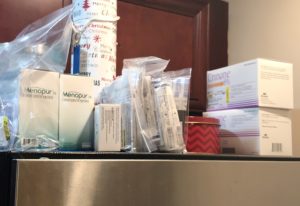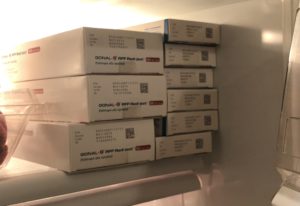The IVF Process Part I: Baseline, Stims, and Monitoring
By Alina Avery
First, our medication arrived from a special fertility pharmacy. It arrived in an insulated box I could almost fit in. Needles and syringes and everything. The nurse warned us that the box would be big when she taught us how to administer the medication at our last appointment. It was still pretty overwhelming.


Our box had several medications in it, some of which needed to stay refrigerated. According to my research, the first IVF cycle can be “diagnostic”, meaning the doctor will see how you respond to a standard dose and if you need to change dosages or protocols in a future cycle, you can adjust to try for a better outcome, meaning more mature eggs that fertilize normally. I was on a standard “antagonist” protocol, which means that my ovaries were stimulated to grow more eggs and then we used an antagonist to prevent them from ovulating until the doctor decided they were ready. The injectable medications I was prescribed were Menopur and Gonal-F to stimulate the ovaries, Cetrotide as the antagonist, and Pregnyl to trigger the release of eggs when they were mature enough to be retrieved. Along with these were a number of syringes and needles to draw up and administer the medication, an empty sharps container, and some alcohol wipes and sterile gauze. The non-injectible medications included in the box were for after the retrieval, to support my body hormonally after we hopefully transferred an embryo back into my uterus. For that I was given an estrogen transdermal patch and a progesterone suppository gel, which was honestly the worst part of the whole ordeal, but I’ll get to that later.
Once my next period arrived, which is day 1 of my cycle, I went in for baseline monitoring. The objective is to make sure you’re ovaries are suppressed before you start stimulating them to produce more follicles, which contain eggs. This is done using an internal ultrasound, which is pretty uncomfortable but you get used to it after undergoing several. They also do a blood test to make sure your progesterone and estrogen and other hormone levels are appropriate for the beginning of a cycle. All of my levels came back within range and my ovaries looked nice and quiet, so I received a call from the nurse that I would start stims that evening.
The nurse confirmed my dosages, gave me a few instructions on timing, and scheduled my first monitoring appointment for four days later. I’d do nightly injections of Menopur and Gonal-F and then they’d check and see how I was responding with another ultrasound and a blood draw. She also reminded me that unprotected sex was not allowed during this time, as there was an increased possibility that I could release multiple eggs while stimulating my ovaries, resulting in a high-risk high-order pregnancy.
Matt did my injections for me, and they really weren’t so bad! They were subcutaneous, meaning they just need to go into the fatty layer right beneath your skin, and they go right into your belly. I will say, there is nothing less flattering than pinching a handful of belly fat for your husband to stick a needle into. But we made the process a bit of a ritual and by the end of the stim period, I kind of enjoyed our few moments together. We’d sit together and have a cup of tea after. The process was really emotional for me, so it was nice to have a few quiet minutes together to decompress.
After my first monitoring session, thing were going well, so I was told to continue the same dosages for three more days and go back again. The second monitoring appointment was when things had started to take off, so they decreased the dosage of one of the stimulating medications and started me on the antagonist. I went in again two days later and was told that we’d reached the point the doctor was looking for and we were ready to trigger! The trigger shot is administered exactly 36 hours before the retrieval procedure, so I was told to do the injection that evening at 8:30pm exactly and then enjoyed a full injection free day before heading in for my retrieval appointment at 8:30am the following day.
Overall, the injections weren’t so bad, but you do get uncomfortable towards the end. Your ovaries are normally the size of grapes, but by the time your ready to trigger, each follicle can grow up to 2 centimeters wide and you can have up to 15 follicles or more on each side, meaning your ovaries swell up more like the size of grapefruits. One of the reasons you’re so closely monitored is to prevent OHSS, Ovarian Hyper-stimulation Syndrome, which is very unpleasant and can result in hospital admission. Doctors may keep your dosages lower to be on the safe side and avoid OHSS. I stimmed for 9 days total and was lucky enough to avoid it.
Next up: the retrieval and fertilization process!
